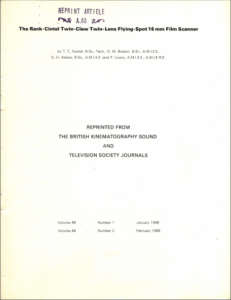35mm film spools gave approximately 10, 20 or 30 minutes running time. 16mm film usualkly offered 30 or 60 minute spools. Two mechanisms are therefore required to provide a continuous viewing of feature films. Changeover was achieved exactly the same as in the cinema, that is, by watching for a cue dot in the top right hand corner of the picture. The 35mm machines took 8 seconds to achieve a stable running speed, so a length of leader film was always present, with numbers printed to indicate the correct start point. TK cues from the production suite would allow for this. When providing film inserts to a studio, we would ’park’ the TK at 10 on the film leader. In a cinema projector this would have given a 10 second run-up time but our machines were quicker.
Cinemas show film at 24 frames per second; TV displays pictures at 25 fps in the UK. To complicate matters, the TV picture is interlaced, that is, each frame is scanned twice at 50Hz with a half line offset.
TV scanning presents a problem with film because the vertical scan flyback time (approx. 1mS) is much shorter than the time taken by a cinema projector mechanism to present the next image. Therefore, in the majority of telecines, the film runs continuously and various methods were employed to arrest the captured image.
See also: BBC Telecine in the 1960s
 |
The Rank-Cintel Twin-Claw Twin-Lens Flying-Spot 16 mm Film Scanner |
| The first twin-lens flying-spot film scanner was designed in 1947 for 35 mm film. A prototype was shown at the B.I.F. in 1948 and two machines went into service with the BBC at Alexandra Palace towards the end of 1950. With the increasing use of 16 mm film it became desirable to develop a machine with a similar performance for use with this film (including colour). Although many of the operating principles are equally applicable to 16 mm, a “scaled-down” version of the original design would have been unsatisfactory in several respects. The first part of the present paper is mainly concerned with those aspects of the 16 mm version which have required new solutions.
|
Back to top
Back to reprint index


